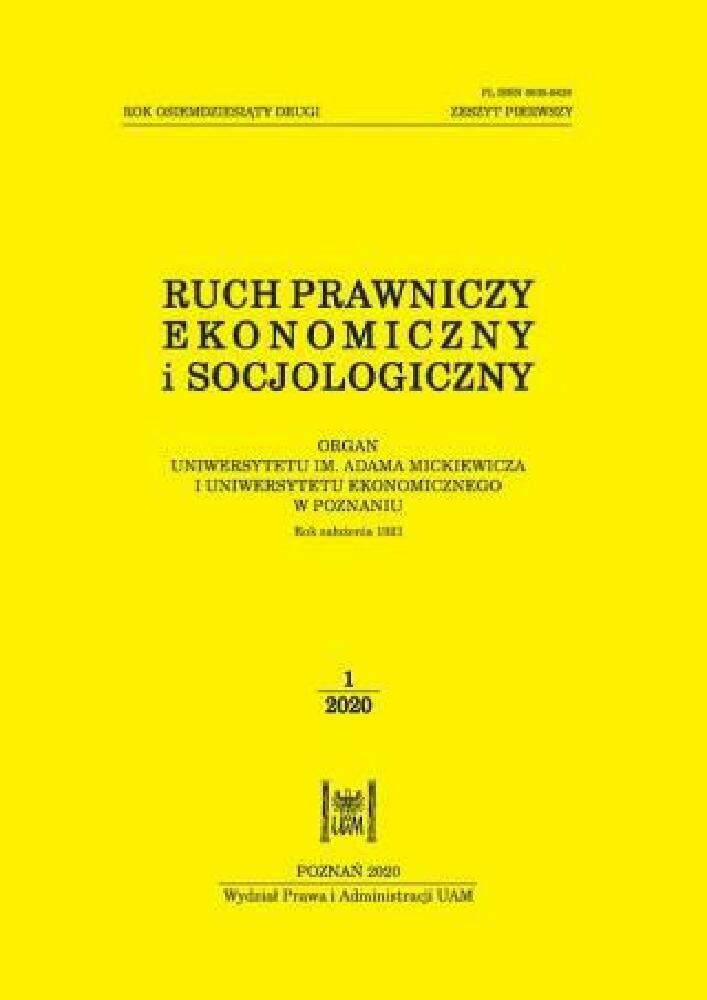Abstract
The paper focuses on the issue of the term of office, recognized as the foundation of the functioning of public authorities in a democratic state. The starting point for more detailed considerations is the recognition that the content of the term of office consists of two basic elements – the temporal one, determining the maximum period during which a supervisor or a member of the body can perform a public function, and the stabilizing one, which ensures there is minimal staff turnover during the term of office. From the entirety of the provisions of the Constitution creating the organizational framework of constitutional bodies of public authority, the author derives the thesis on the obligatory nature of the term of office of each body, unless there is a clear legal basis justifying the opposite. However, this does not mean that the constitutional regulations regarding the term of office of individual bodies are shaped according to a uniform pattern. On the contrary, different types of the term of office can be distinguished on the basis of the Constitution. Analysing particular models of the term of office, the author gives practical examples of normative solutions and indicates the consequences resulting from their application. The conclusion presents the view that the term of office is a constitutional structure guaranteeing the authorities a certain latitude or independence in the process of realizing their legal competences.
References
Brzozowski, W. (2016). Niezależność konstytucyjnego organu państwa i jej ochrona. Warszawa.
Brzozowski, W. (2017). O potrzebie reformy konstytucyjnej. Państwo i Prawo 72(12): 3–22.
Garlicki, L. (1999). Komentarz do art. 98, uwagi 7–8, [w:] L. Garlicki (red.), Konstytucja Rzeczypospolitej Polskiej. Komentarz. Tom 1. Warszawa: 8–11.
Grajewski, K. (2009). Odpowiedzialność posłów i senatorów na tle zasady mandatu wolnego. Warszawa.
Grajewski, K. (2018). Przedterminowe zakończenie kadencji Pierwszego Prezesa Sądu Najwyższego w świetle art. 12 § 1 oraz art. 111 § 1 i § 4 nowej ustawy o Sądzie Najwyższym. Gdańskie Studia Prawnicze 40(2): 609–620.
Gwiżdż, A. (1975). Organizacja i zasady funkcjonowania, [w:] A. Burda (red.), Sejm Polskiej Rzeczypospolitej Ludowej. Wrocław–Warszawa–Kraków–Gdańsk: 239–337.
Hofmann, H., Dreier, H. (1989). Repräsentation, Mehrheitsprinzip und Minderheitenschutz, [w:] H.P. Schneider, W. Zeh (Hrsg.), Parlamentsrecht und Parlamentspraxis in der Bundesrepublik Deutschland. Berlin–New York: 165–198.
Jastrzębski, J., Zubik, M. (2007). Mandat wolny versus weksel. Przegląd Sejmowy 15(2): 67–85.
Korczak, J. (2014). Kadencyjność organów jednostek samorządu terytorialnego. Samorząd Terytorialny 24(7/8): 38–50.
Kretschmer, G. (2009). Kommentar zu Art. 39, Randnummer 43–46, [w:] W. Kahl, Ch. Waldhoff, Ch. Walter (Hrsg.), Bonner Kommentar zum Grundgesetz. Ordner 10. Heidelberg: 30–33.
Ławniczak, A., Masternak-Kubiak, M. (2002). Zasada kadencyjności Sejmu – wybrane problemy. Przegląd Sejmowy 10(3): 9–26.
Łukowiak, D. (2018). Charakter prawny kadencji wybranych członków Krajowej Rady Sądownictwa (uwagi na tle wyroku Trybunału Konstytucyjnego w sprawie K 5/17). Przegląd Legislacyjny 25(2): 63–79.
Magiera, S. (2018). Kommentar zu Art. 39, Randnummer 3, [w:] M. Sachs (Hrsg.), Grundgesetz. Kommentar. München: 1253.
Morlok, M. (2015). Kommentar zu Art. 39, Randnummer 10, [w:] H. Dreier (Hrsg.), Grundgesetz. Kommentar. Band 2. Tübingen: 1138–1139.
Radajewski, M. (2018). Glosa do wyroku TK z 20.06.2017 r., K 5/17 (wybór członków Krajowej Rady Sądownictwa). Państwo i Prawo 73(3): 132–139.
Radajewski, M. (2019). Constitutional aspects of the reform of the Polish justice system in 2017–2018. International and Comparative Law Review 19(1): 276–293.
Schliesky, U. (2018). Kommentar zu Art. 39, Randnummer 23, [w:] P.M. Huber, A. Voßkuhle (Hrsg.), Kommentar zum Grundgesetz. Band 2. München: 1102–1103.
Schneider, H.P. (1989). Kommentar zu Art. 39, Randnummer 5, [w:] R. Wassermann (Hrsg.), Kommentar zum Grundgesetz für die Bundesrepublik Deutschland. Band 2. Neuwied–Kriftel–Berlin: 64.
Siemieński, F. (1980). Prawo konstytucyjne. Warszawa–Poznań.
Skrzydło, W. (1997). Konstytucyjne założenia systemu organów państwa i ich wpływ na kształt aparatu państwowego, [w:] W. Skrzydło (red.), Ustrój i struktura aparatu państwowego i samorządu terytorialnego. Warszawa: 7–34.
Versteyl, L.-A. (1989). Beginn und Ende der Wahlperiode, Erwerb und Verlust des Mandats, [w:] H.P. Schneider, W. Zeh (Hrsg.), Parlamentsrecht und Parlamentspraxis in der Bundesrepublik Deutschland. Berlin–New York: 467–488.
Zubik, M. (2005). Powoływanie członków Rady Polityki Pieniężnej w świetle zasady kadencyjności oraz działalności organów państwa. Przegląd Sejmowy 13(4): 37–52.
Zubik, M. (2010). Organy centralnego banku państwa między legalizmem a koniecznością, [w:] M. Modrzejewska (red.), Prawo handlowe XXI wieku. Czas stabilizacji, ewolucji czy rewolucji. Księga jubileuszowa Profesora Józefa Okolskiego. Warszawa: 1419–1428.
Zubik, M. (2011). Status prawny sędziego Trybunału Konstytucyjnego. Warszawa.
Zubik, M. (2018). Między profesjonalizmem a głosowaniem większości w demokratycznym państwie prawa. Zeszyty Naukowe Sądownictwa Administracyjnego 14(5): 65–74.
License
Copyright (c) 2020 WPiA UAM

This work is licensed under a Creative Commons Attribution-NonCommercial-NoDerivatives 4.0 International License.





